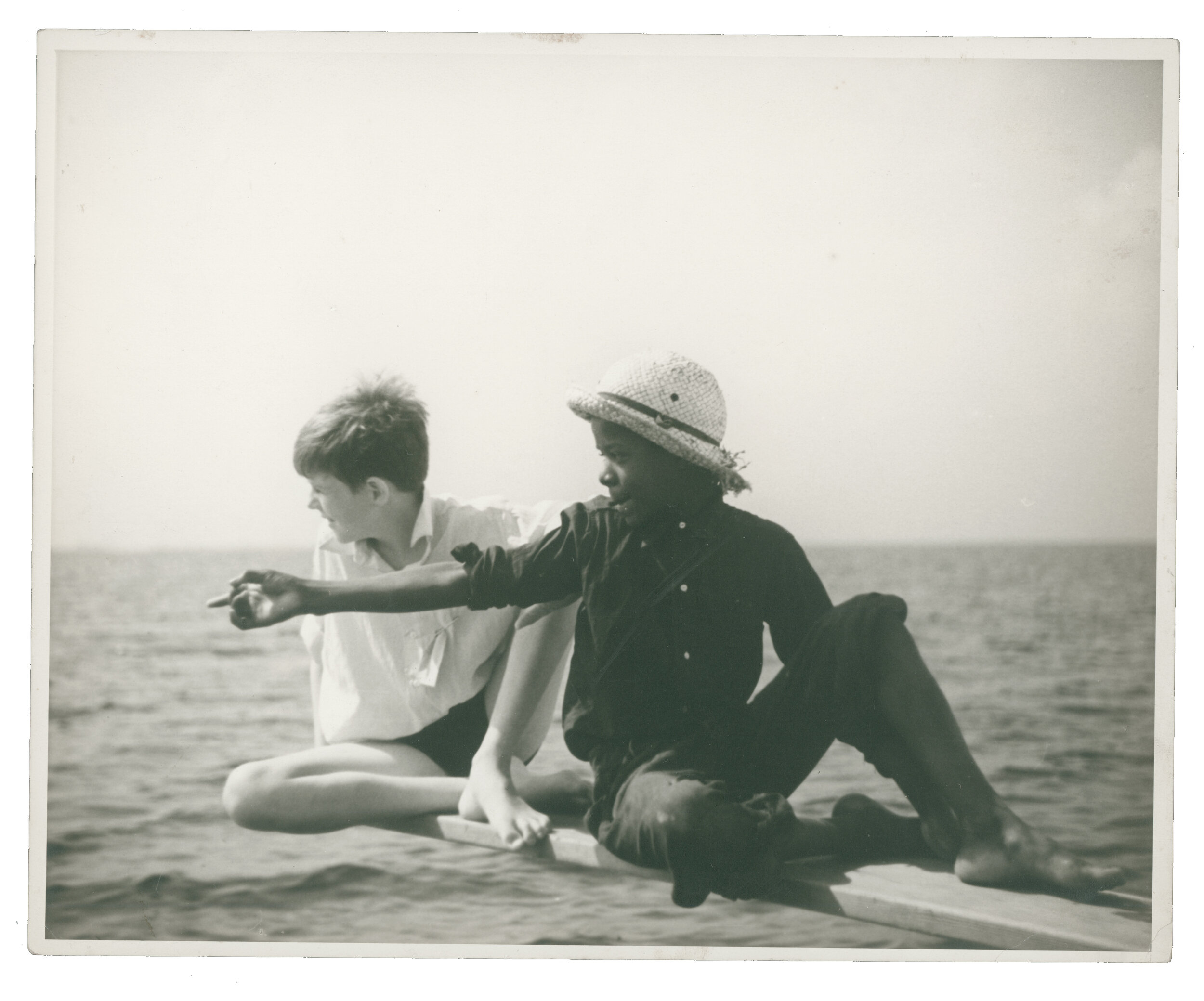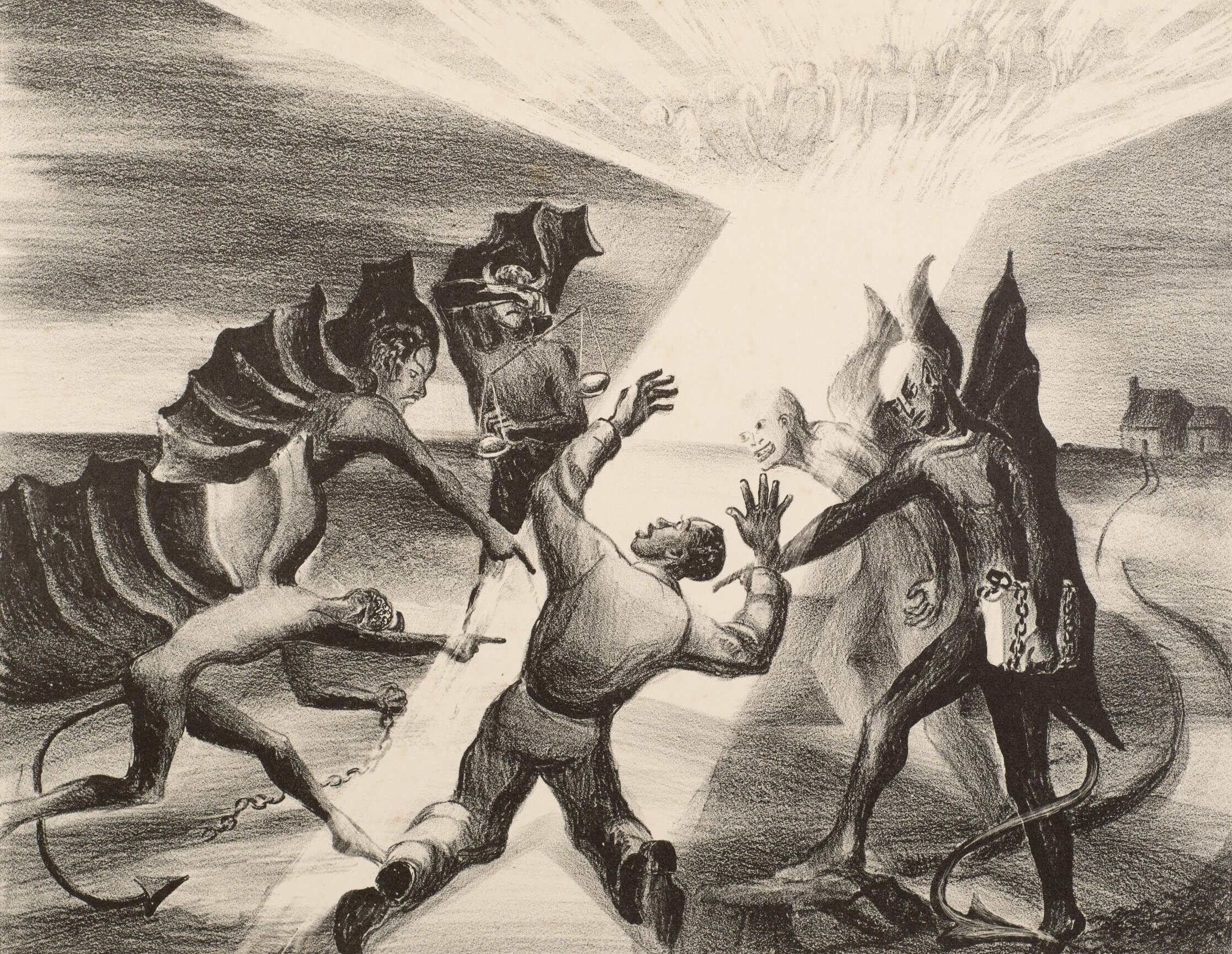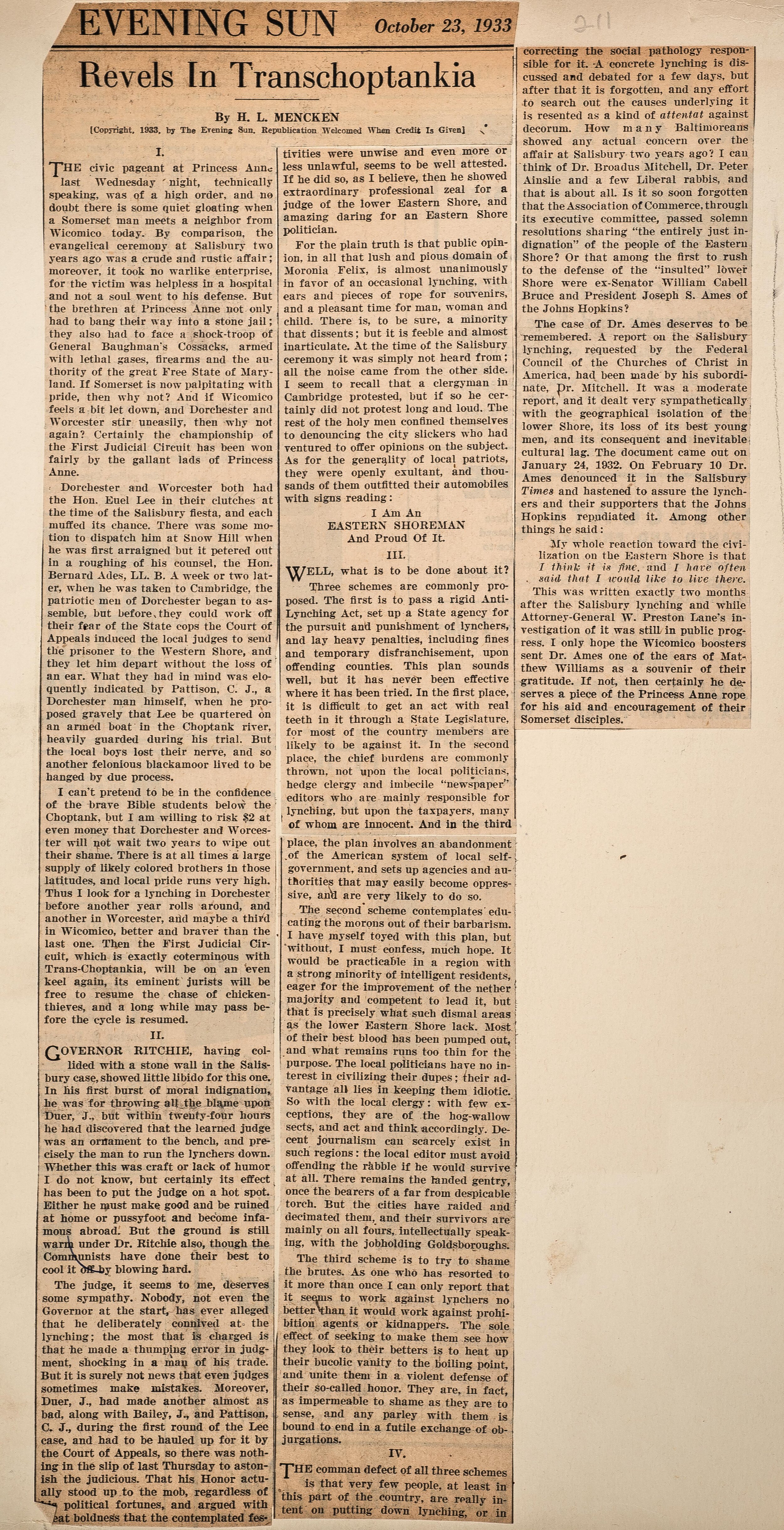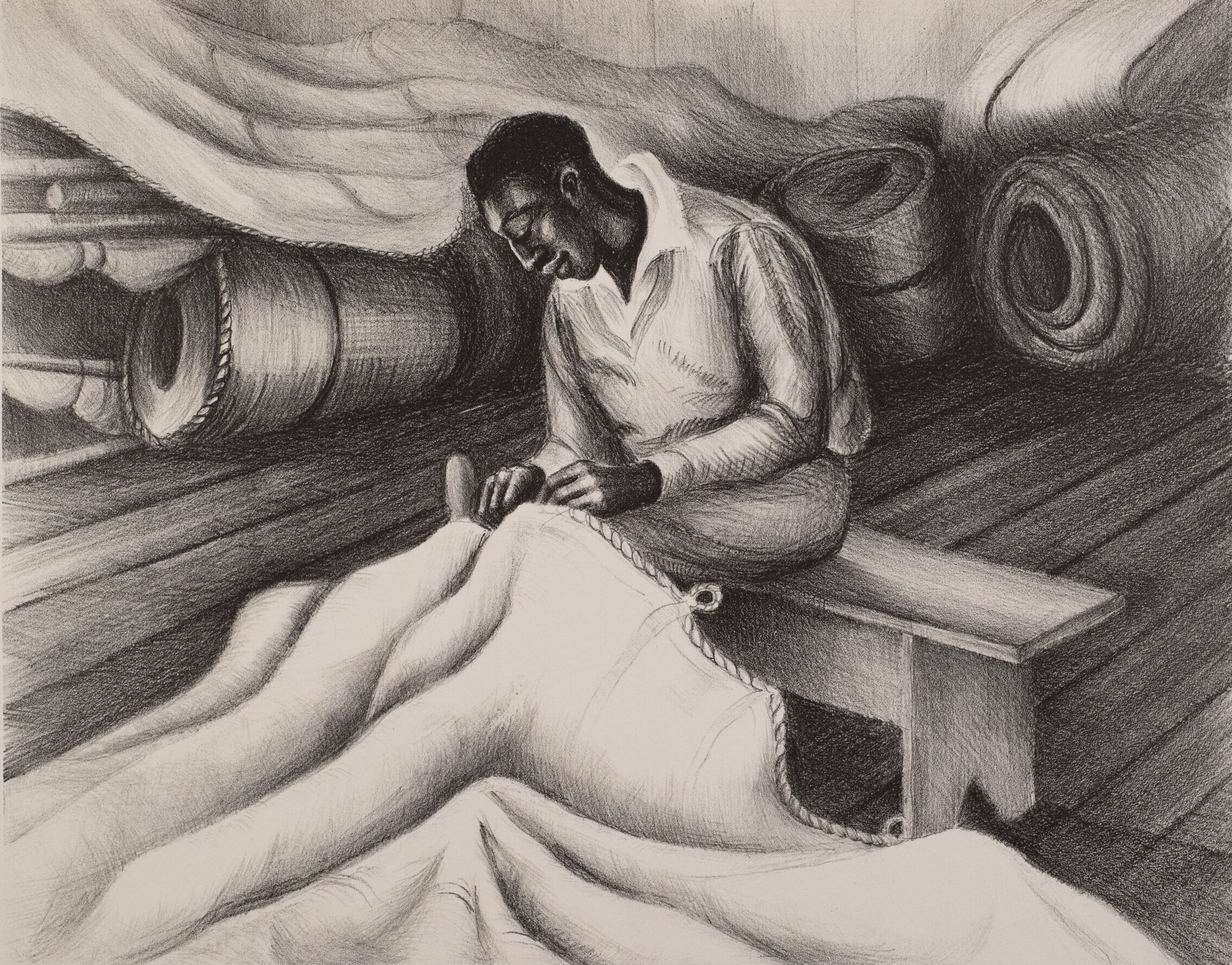
The Water’s Edge Museum proudly presents Black farmers, professional sailmakers, military figures, musicians, watermen, and crab pickers—The Founding Black Families of America who harnessed knowledge and power, and placed it firmly and confidently into the hands of their descendants.
Downes Curtis, black-and-white lithograph, 1935
The Museum seeks to empower the young people of today to find their place in history and identify their own positive and unique voice when facing contemporary issues and challenges.
See how people of color on the Eastern Shore lived and how their lives mattered.
Find yourself at The Water's Edge.
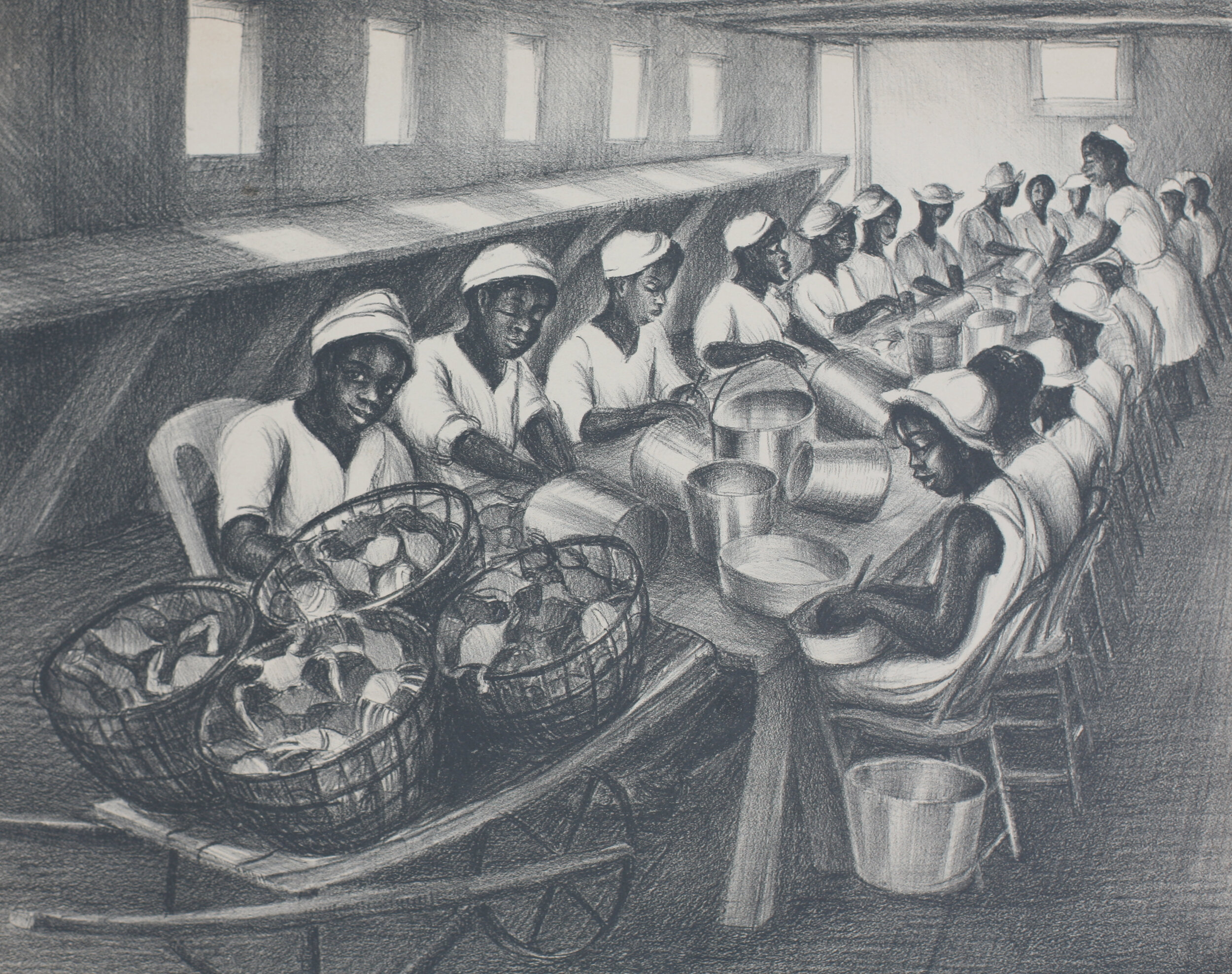
Maryland crab pickers, black-and-white lithograph, 1933
Jonah and the whale was featured at the 1937 Paris International Exposition, color serigraph, 1933. “Long ago the slaves sang, ‘If the Lord delivered Jonah from the belly of the whale, He will deliver me.’ And these words came too. The Negro race has been delivered from dangers and torments worse than Jonah knew, they have been given a vision of the freedom that can finally be complete.” –Words of artist Ruth Starr Rose (1887-1965)
AT THE WATER’S EDGE
Many of Maryland’s founding African American families led their lives at the water’s edge on the Eastern Shore. This maritime region—which boasts the oldest extant free Black community in America—is noted for its natural beauty, isolation, as well as for its unique perpetuation of an Elizabethan English dialect.
As home to important figures, such as Harriet Ross Tubman, Frederick Douglass, Ayuba Suleiman Diallo, Henry Highland Garnet, Charles Albert Tindley, and Waters Edward Turpin, it contains a long and rich African American history. Yet the story behind these luminaries has gone largely unrecognized.
The Flood illustrates the vulnerability of life for people of color dwelling at the water’s edge along the Chesapeake Bay. Charcoal and pencil drawing, ca. 1925
Over 80 years ago, the African American author Waters Edward Turpin penned an eloquent description of life on the Eastern Shore in his novel, These Low Grounds (1937):
“It is a low, flat land, the Eastern Shore of Maryland. It crouches there between the Chesapeake on the west and the state of Delaware on the east. It crouches there, the Shore, like a sulking, neglected child, with its scattered hamlets, towns, and villages. Some of them have caught the modern spirit; others lie in dull contentment with their lot beneath whatever kind of sky the fates provide. The farmers plow, plant, and reap. The river men snatch their produce from the streams. The canners pack their tomatoes and peas. And natives of all persuasions are born, live, propagate, decline, and are buried beneath the low, flat land, in order that their children may take up the thread of life.”
Eastern Shore steam thresher, 1932, oil on Masonite
BLACK LIFE ON THE EASTERN SHORE
The Water’s Edge Museum is honored to present a collection of literature, paintings, lithographs, frescoes, and drawings of African American life created over 100 years ago. This is the first time that these elements have been fused together in an exhibition that describes the process of creating works of art to celebrate daily life, spirituality, and the environment. Moreover, the museum reflects upon the artistic process of documenting life at the water’s edge–and to promote healing through a deeper understanding.
The portraits, many of them done in oil, accord their subjects a refreshing dignity that was revolutionary at the time they were painted. The exhibition also includes work in other media, including the visual arts, literature, and music. The collection aims to expand our knowledge of the history and culture in some of America’s earliest Black communities.
Through art and culture, The Water’s Edge presents an uplifting story of a people who tended to be relegated to the caste of the invisible.
Black-and-white photograph of Downes and Albert Curtis’s historic sailmaker’s loft on Tilghman Street, Oxford, ca. 1930. Courtesy of © Mr. and Mrs. George Albury
Bernard Moaney as a duck hunter, oil, 1931
The Afterglow of Ruth Starr Rose with Jeffrey Moaney
Please enjoy the video above about the descendants of those who lived on the eastern shore by the Talbot Spy Newspaper of Maryland.
Boy in church clothes, oil, 1933
THE FOUNDING BLACK FAMILIES OF AMERICA
From thriving villages in West Africa, people of color were brought to Maryland to plant, tend, and harvest tobacco. Loaded into the lowest level of crowded ships, they were brought to many other places including South Carolina where they cultivated millions of acres of low country rice. From Mozambique Island, they were brought to New York in shackles and bartered to fell trees for New England’s lucrative shipbuilding industry. However conflicted they may have been, the Founding Fathers of America acknowledged that slavery was a critical building block toward creating the solid foundation of democracy. Enslaved persons fueled the engine that would become the new democracy. They made up the backbone of America’s deepest stain—the global slave trade. These were America’s enslaved Africans, and in their way, Founding Fathers of America. On African soil, they knew themselves as Ota Bendi, Kunta Kinte, Olaudah Equiano, and Ayubah Suileman Diallo. Once they were relocated to a plantation they were given new names: Hercules, Nero, Toby, Kizzie, and Modesty.
The Water’s Edge Museum embraces the complex stories of the Founding Black Families who harnessed their power, and placed it quietly but resolutely into the hands of their descendants. The museum honors how they lived, and how their lives mattered. Privately aware of the accomplishments of their forebears as African tribesmen and nobility, these individuals were resilient, and excelled as professionals, exemplary in their own right. In spite of pervasive racial injustice, they forged ahead to stake a claim in the America that needed them, but continued to refuse to acknowledge them for their crucial role. At least until now.
Presenting the Founding Black Families of America as a portrait of a people on the Eastern Shore, The Water’s Edge Museum offers a first look at the invaluable role played by people of color through their loyalty, devotion, and bedrock spiritual foundation. The museum sets out to showcase the powerful work ethic, patriotism, religious history, and musical integrity of a culture that had been either ignored, underestimated, or undervalued. The primary goal is to support people of today in finding their place in history and identifying their own positive and unique voice when tackling inequity.
This story is relevant to all audiences—from underrepresented youth to their elders—as it delivers important lessons of collaborating with others outside of one’s own comfort zone to create a better world.
Exploring through art the portraiture, patriotism, spiritual beliefs, and earliest sacred music handed down to families of early African American leaders, the exhibition fosters the kind of community spirit that celebrates America for its diversity. Focusing on the Eastern Shore, the exhibition makes a side glance to its greater American context. The Water’s Edge compares the visual arts, music, and written words of Hervey Allen, Mabel Dwight, Dubose Heyward, Langston Hughes, Victoria Hutson Huntley, Zora Neale Hurston, Julia Mood Peterkin, Josephine Pinckney, Paul Robeson, Ruth Starr Rose, Gertrude Stein, Doris Ulmann, and Waters Turpin.
Madonna, black-and-white, 1934
Isaac Copper in a suit, oil, 1931
Many of the artists behind the work were women of European descent. This in itself is a revelation. The artists were able to live comfortably in a shared community–one which fostered an extraordinary documentation of oral histories, achievements, spiritual beliefs, and melody of people outside of their own social circle. This exhibition provides a view of integrated worlds in which diverse populations lived harmoniously, despite being set in times of harsh racial segregation.
As an example, Gertrude Stein was credited as the first to depict black people not as a “spectacle,” but as natural members of the human family. Julia Mood Peterkin is noted as the first Southerner to win a Pulitzer prize for Scarlet Sister Mary; a book written largely in the Gullah dialect that honestly portrays the plight of a 1920s woman of color laboring to become independent. Peterkin and New York-based photographer Doris Ulmann collaborated to professionally photograph and record the daily life and spirituality of black people from South Carolina and Alabama. After graduating from Vassar College, Rose spent decades at the New York Art Students League, ferrying her liberal professors and peers to her family’s isolated plantation on Maryland’s Eastern Shore. It was there that she and her small circle of urban friends honored her neighbors as direct descendants of African chiefs, Frederick Douglass, and Harriet Ross Tubman.
A list of the children who attended Sunday School at the historic Copperville Church in 1940.
INTERPRETING AFRICAN AMERICAN SPIRITUALS
Perhaps most significant is the collection depicting African American spirituals as envisioned by the congregations of black families from the Eastern Shore. In 1956, Howard University Professor James Amos Porter singled out this set of prints as the most comprehensive and sympathetic set of illustrated African American spirituals to date. As such, they exemplify the visual representation of one of America’s earliest art forms. At the time, they were as radical as James Weldon Johnson’s books on spirituals; with his accounts of the dissonant harmony of songs embodying the marriage between the Anglo Saxon King James Bible and ancient African rhythm. The illustrations are enhanced by recorded histories from the descendants of founding families of color, which explain the important untold histories of enslavement and freedom that were hidden in these songs. The words were deeply coded; in most cases forbidden on plantations, as they often marked the prelude to a rebellion.
Despite its rural isolation, Howard University’s exhibition put the spirituals as visual art and the Eastern Shore on a greater map of cultural excellence. Recognizing the popular reponse, Porter extended the dates of the exhibition, declaring it unrivaled for its directness and honesty. The interpretations of African American spirituals were thoughtfully executed with a compassion so that many assumed that the artist—like the student population—was also black.
Spiritualistic study of a wheel in the air delivering faith to people of all hues age, and ability, charcoal on paper, 1928
Made a century ago, the spirituals presented in The Water’s Edge illustrate the early spirituals exactly as the congregation envisioned them and recorded the words precisely as the choir sang them.
“Uninhibited by radio or Broadway fame, African Americans on the Eastern Shore sang to their God with a kind of religious urgency and humbling purity. Life on the Eastern Shore plantation was based on ships in the beginning. The water was a highway and sustenance and the great world beckoning. It was everywhere around us and we grew to watch its every mood. Like a brood of ducks that has been hatched out by a hen, we took to the water. Though we did not know it, we were being taught in a hundred ways by the colored people. We learned about the winds and the tides, those mysterious forces that changed the face of our world twice a day.” –Ruth Starr Rose
Book of African American spirituals given to a Maryland artist by a New York art dealer who recognized the significance of supporting artists who honored the music and culture of people of African descent on Maryland’s Eastern Shore.
Couldn’t hear nobody pray, black-and-white lithograph, 1943
“Way down yonder by myself, I couldn’t hear nobody pray. From the time that the first Negro landed in America to the Great World War is two hundred years or more. Now again the colored man goes back to the jungles of the equator, this time to fight for his country. The old spiritual that expresses the fundamental and inevitable loneliness of man – here has a new meaning – yet keeps its eternal truth and power. The soldier in the South Pacific is trying to contact his outfit, all around him are the noises and confusion of battle – overhead the forces of evil are coming down to battle with him from the skies. Here all alone deserted he listens desperately and ‘He couldn’t hear nobody pray.’ Because if all people were really praying, for the fine things he expects of prayer – there would be no forces of evil descending and there would be no wars any more.” –Words of the artist
Standing in the need of prayer, black-and-white lithograph, 1944. “Carried away by the magnificent melody and rhythm of these great songs, do the white people remember the stark truth and the simplicity of their words? For who among us is not standing in the need of prayer?” –Words of the artist
Pharaoh’s army got drownded, fresco, 1940. This was made to honor the son of the minister of the Copperville Church who had given his life in training for World War II. This fresco was, according to the Christian Science Monitor (1955), the first work of art made by a white person for a black church.
'“Let my people go. This song of liberation has many variations, Go down, Moses, Didn’t old Pharaoh get lost, Oh Sister Mary, Don’t you weep. Being a basic theme of the release of an oppressed people from bondage, these songs have meaning not only for other days, but look to more freedom now for the colored citizens of a democracy. One day in Maryland I was visited by the preacher of the African Methodist church. He asked if I would do a painting for the altar, and how much I would charge. Telling him I would be glad to do the painting just for the pleasure of having his people enjoy it, I used this design of Pharaoh’s Army Got Drownded, It was done on a large plaster panel in the ancient technique of true fresco. After completion, it was moved two miles down the long lane, and through the dark southern pine forests to the little church of Copperville, Maryland. With the help of the elders and the preachers, the painting had a safe though adventurous journey through the mud, on the running board of the preacher’s car. Installed at last in its place of honor above the pulpit and the Bible, it was unveiled with much ceremony, with singing and with ringing words of preaching, ennobled by the fine native dignity of the Negroes, In gratitude, the brethren of the church asked me if they could come to my house in June, when the honey locust is blooming by the tidewater and bring a chorus of 50 singers. The great day came; turning into a festival of white and colored for the benefit of the Copperville church. Choruses and quartets sang, and a young Negro preacher spoke, ‘Lo, how good and how beautiful it is for brethren to dwell together in unity.’” –Notes by the artist
Maryland Spirituals Initiative
Bringing an empowering history to life, through artistic representation, written accounts, and oral histories, with a selection of songs recorded by an intergenerational choir of Marylanders.
“You love life and living quality; here is life all around you. Paint what God has given you, the life of the people who work for you, who live all unnoticed in this remote community. So, the idea came to make a record of the life of the Negroes of the Eastern Shore. It had never been done and is still unique in the annals of art.” -Ruth Starr Rose
Ruth Starr Rose (1887-1965) playing the harp, black-and-white photograph, 1915
Black-and-white photograph of the artist Ruth Starr Rose with her son and children from Copperville on her racing yacht, the Belle M. Crane in 1933
ABOUT RUTH STARR ROSE
Painter and printmaker Ruth Starr Rose (1887–1965) wrote these words after realizing that her lifelong pursuit would be to document and celebrate the lives of her African American friends and neighbors in the tiny, historically black towns of Copperville and Unionville, on Maryland’s Eastern Shore. Descending from Wisconsin abolitionists, Rose came from a wealthy white family that was also endowed with a keen, progressive, social conscience. As she grew up, she developed an abiding love and respect for her friends who were of African descent–who taught her not only practical but spiritual life lessons. She also labored to chronicle through art the religious beliefs she shared with her neighbors as she worshipped alongside them in an A.M.E. church. Although her work on spirituals was never published, it has recently been rediscovered, along with her notes for it.
Ezekiel saw the wheel, final ink study for the black-and-white lithograph. “Ezekiel saw the wheel. Way in the middle of the air, the little wheel turns by faith and the big wheel turns by the grace of God. Working in the fields, in close kinship with nature – the Negro relates all the wonders of the land and sky to the kingdom of God. What more beautiful than this – He that hath eyes to see let him see – He can look over the harvest and the sowing and in it see miracles. The colored man – expert with this mules, skillful, patient – talking to them and singing as he works – looks in awe at the pageant of the sky and salutes his Creator in song. Using the simple symbols of his life – the plough and wheel – the storm, a modern Ezekiel still hears the voice of his God in the thunder.” –Words of the artist
BLACK LIVES MATTERED ONE HUNDRED YEARS AGO
The story behind this exhibition unfolds in the first half of the 20th century, within a remote region of the Chesapeake Bay where abolitionist Frederick Douglass once lived as an enslaved child. It includes the Hill in Easton, Oxford, St. Michaels, and the historic settlements of Unionville and Copperville, which were vibrant African American communities, each with its own A.M.E. church. Located near the 17th-century town of St. Michaels, Unionville and Copperville were comprised of small parcels of land awarded to courageous African American soldiers who fought during the Civil War.
The chronicling of people of African descent, portrayed with innate nobility and dignity, created decades prior to the civil rights movement, and at a time when the scar of slavery was still within living memory, was visionary in its content and healing qualities. The prints, drawings, and words weave together visual and written accounts leaving a remarkable account of African American daily life, religious beliefs, and genealogy. The legacy is more than a rare portrait of a people: It is a history teaching us how images of people’s strength were presented to overcome adversity. This is a story of how art and culture validated lives and promoted true societal integration.
George Moaney teaching Richard Rose about life on the water, black-and-white photograph, 1933
Rose’s mother was an accomplished musician, who also wrote for elite gardening publications, publishing as early as 1909 about the African American wisdom that allowed her garden to flourish on her Talbot County property. Rather than showcasing herself with secateurs, she arranged for glossy magazines such as Country Life and Gardening to feature the tall, slender gardener Isaac Copper, whose grandfather had been a chief in Africa.
Rose knew that her work was important. Encouraged by supportive family, friends, and her colleagues at the Art Students League of New York, Rose embarked as early as 1930 on a what was regarded at the time as a visionary project to create an illustrated book about her friends’ peaceful, meaningful lives. In her mission statement, Rose outlined the originality and breadth of her undertaking:
“I plan to show in paintings and lithographs the life and industries of the Eastern Shore of Maryland, with special reference to all native customs and activities of the Negroes and white tenant farmer. This rather remote and not very well known part of the world has great possibilities that have never been explored.”
Keep your hand on the plow, hold on, black-and-white lithograph, ca. 1950
Paul Robeson receiving spirituals honoring Eastern Shore spirituality before a concert in Newark in 1941. Black-and-white photograph from the Montclair Times. Paul Robeson’s visionary beliefs as a nascent civil rights leader were a match for the prints of Little David play upon your harp and also Ezekiel saw the wheel. Both black-and-white lithographs honored the handsome local singer, ventriloquist, and noted hoodoo, Samuel Julius Johnson.
Charcoal sketch of Paul Robeson singing at the Newark concert in 1941. The large American flag was proudly displayed as a backdrop to a man who at the time was being monitored by the F.B.I. as a suspected Communist.
Go down Moses, black-and-white lithograph, n.d.
Sometimes I feel like a motherless child, black-and-white lithograph, 1943. “The subject of this print is situated in a typical Eastern Shore landscape, and tells the story of how men of color struggle in a world full of pitfalls and obstacles set against them. Menacing demons, one holding scales which are tipped, block the path leading to his home.” –Words of the artist
The community benefited in the fact that the artist was in the position of being able to travel to unusual, often challenging, destinations. Assuming the mantle of a cultural anthropologist, she was able to overcome her outsider status by building local relationships and unobtrusively observing religious customs. Her portraits and scenes go beyond realism or mere representation to achieve a creative, truthful documentation of black life throughout the world. She also documented daily life and religious festivals of Native Americans in New Mexico and Florida, as well as creating works that shed light on the people of Mexico and Haiti.
Fueled by a natural curiosity and with a progressive education from Vassar College, Rose was able to ask difficult questions. She bravely crossed gender, economic, social, and color lines to chronicle an overlooked chapter in American history: everyday life on the Eastern Shore. Rose never forgot the important lessons she learned from her African American neighbors. Even though she spent the last twenty years of her life in places as varied as Mexico and Montana, at her death, her ashes were returned to the water’s edge of the Chesapeake Bay.
Study of an angel watching over incarcerated men in shackles, ca. 1928
There is a City Called Heaven
There is a City Called Heaven honors early African American spirituals recorded by artists, singers, and writers on Maryland’s Eastern Shore over one hundred years ago.
Welcome to our online platform, which includes an illustrated book for everyone interested in culture, theology, art, history, the nascent civil rights movement, and music.
The old ark’s a’moverin (and I’m going home), color lithograph, 1938. “To the colored people on the tidewater, Noah’s Ark is not fantastic. Singing about the Ark, the Negroes are thinking about their church that provides them with refuge for sailing steadily through life. They feel that the inevitable progress of the Ark toward the rainbow’s end typifies the long and dangerous voyage toward freedom and goodwill. Instead of home being on this earth, home is that blessed realm of heaven where all will be equal in the sight of God. The Eastern Shore Negro is an expert waterman. In oyster boats and running crab lines, he braves the elements to feed our country. The call of the Chesapeake is in their sailor songs”. –Words of the artist
ART ACTIVISM ON THE EASTERN SHORE
It took great courage to make the decision to live in a fully integrated world one hundred years ago. This was particularly true in this region, which was noted as the place of the last lynching in Maryland. Racial injustice was the central problem people had to grapple with on Maryland’s Eastern Shore.
For the brave writers and artists who left an uplifting chronicle of life featured at The Water’s Edge Museum, Black Lives Mattered One Hundred Years ago. They chose to live by their own personal code of ethics, creating racial equality in art by giving an array of honest visual and written representations to a largely marginalized population.
Over 80 years ago, Baltimore’s sage, H.L. Mencken, “Revels in Transchoptankia,” condemned the Eastern Shore for a rash of unpunished lynchings. Mencken labeled conspirators as “Trans-Choptankians,” who, in their bigotry, read like characters in a William Faulkner story. Mencken’s expression of anger and despair for such heinous crimes are echoed by Morgan State University professor Waters Edward Turpin’s words from his first novel, These Low Grounds, published in 1937 shortly after that time:
“What right have I,” he asked, “or any other man here in this town—or in America, for that matter—to marry a woman whose children I can give no protection from a lynch mob? We’ve love to give each other the right to live here in these Low Grounds, as your grandfather calls them. We belong here as much as the other groups of Americans. We’re no more or less than the other Americans. We’re just people…all of us…north, south, east, west…Americans…And in our working, our loving, our sorrowing, and our dying we are making the America of Now and Tomorrow, just as we helped to make it Yesterday.”
Peace, color serigraph, ca. 1950
The Salisbury Riots, recorded by the Baltimore Sun, black-and-white photographs, November, 1933. © Courtesy Baltimore Sun Media Group. Members of the National Guard point guns at a white mob in the violent aftermath of the lynching of Maryland citizen George Armwood. Over 2,000 members of the National Guard were deployed to Salisbury to control rioting white mobs.
Portrait of Reverend Davis and lynching, oil, 1933
Note how Reverend Davis, the local preacher from the A.M.E. church of Copperville stands calm, focused, and resolute at his podium preaching while a lynching occurs behind his left shoulder. As a person of color with deep roots on the Eastern Shore, Waters Edward Turpin’s words from his last novel, The Rootless (1957) bear witness to the memory of the haunting memories of slavery and its aftermath:
Throughout these obvious distortions of the folk-mind, however, one thread of constancy weaves: a somber chronicle that begins in the foul belly of a slave ship and ends in a gutted ruin.
To this day, Oxford, Maryland remains the only UNESCO-documented Middle Passage stop on the Eastern Shore of Maryland, Delaware, and Virginia. There is no sign commemorating this fact.

He’s got the whole world in his hands, black-and-white lithograph, no date
“I want my prints to stand as an expression of universal brotherhood.” –Words of the artist






















